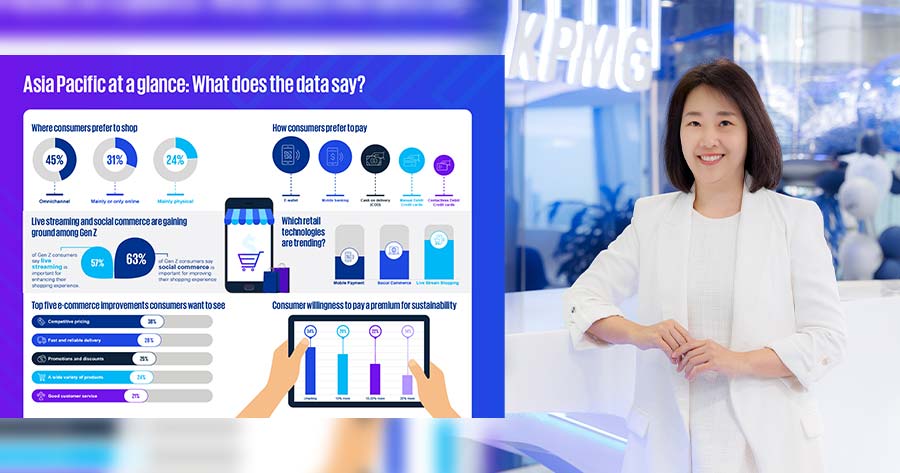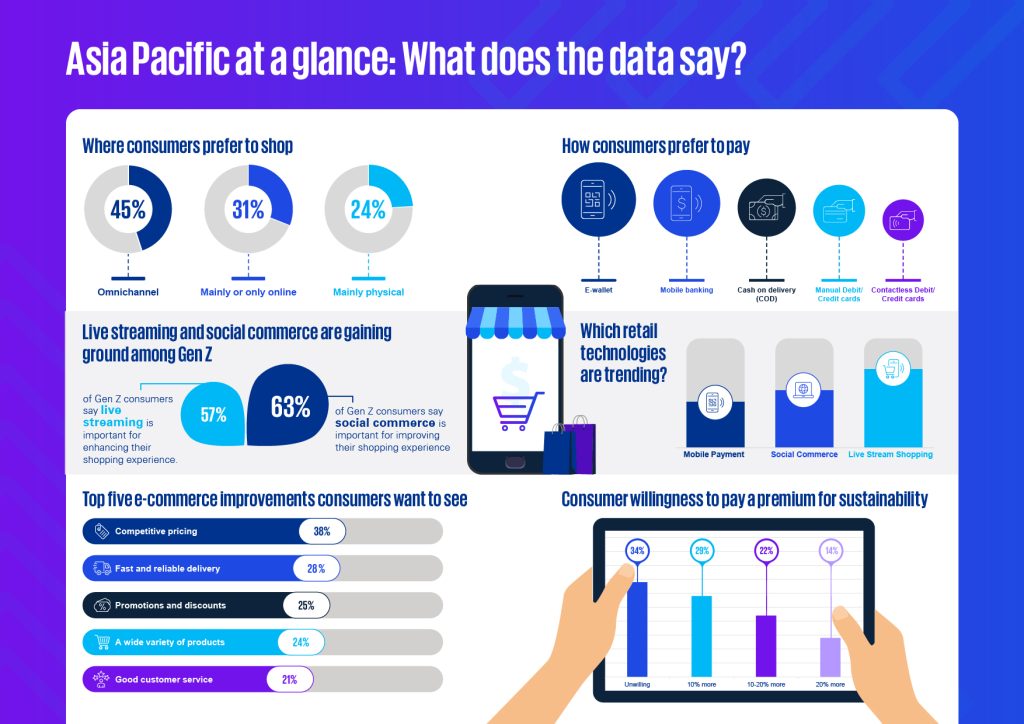The emergence of seamless retail, with digital transformation propelling remarkable advancements in the sector, has put the customer squarely at the center of attention, marking a new era. Concepts which once dominated the space, “such as multichannel” and “omnichannel”, have lost their relevance, with a highly customer-centric approach taking the lead.
A new report by KPMG Asia Pacific and GS1 – ‘Navigating the Future of Seamless Commerce in Asia Pacific: How Retailers are Driving Customer Experience, From Technology to Sustainability’ – examines how businesses and consumers in the Asia Pacific are embracing these seamless commerce strategies across diverse markets and geographies.
The report notes that once a differentiator, seamless retail – encompassing a brand’s ability to recognize and integrate the customer journey across multiple platforms and services – is now a baseline expectation in a majority of the markets surveyed, making it the new benchmark for tomorrow’s sellers. The expectation is that social media, delivery innovations, apps, websites, automated messaging, and other digital interactions – all seamlessly integrate with traditional brick-and-mortar stores.
“Putting consumers first by adopting seamless, connected capabilities across the entire organization is no longer just a competitive edge, but a necessity for those who want to lead the market. ‘Navigating the Future of Seamless Commerce’ seeks to play a key role for the industry to identify opportunities, spurring innovation to better develop more successful customer experiences and journey maps.”
Anson Bailey
Head of Consumer & Retail
KPMG Asia Pacific

“At KPMG, we believe that retail is undergoing a third wave of digital disruption, marked by the advent of seamless commerce. Previous to this, online and bricks-and-mortar stores largely operated independently, as silos. But through the emergence of omnichannel strategies, using data analytics and AI, retailers are now creating synergies across these different channels. With seamless commerce, we are now entering a new phase of retail evolution, one where the customer journey is at the forefront.”
Chortip Varutbangkul
Partner, Head of Consumer & Retail
KPMG in Thailand
About 7,000 respondents were surveyed across 14 markets in the Asia Pacific region: China, Hong Kong SAR, Taiwan, Australia, New Zealand, India, Japan, South Korea, Singapore, Malaysia, Thailand, Indonesia, the Philippines, and Vietnam. The report also draws upon interviews with senior C-suite-level executives from market-leading retailers, brands, and e-commerce marketplaces.
Highlights of the report include six key trends transforming retail, with retailers progressively expected to deliver on seamless retail, through integrated, connected capabilities to meet consumers on their terms.
- Remarkable diversity – Given that the e-commerce landscape in the region is marked by a lack of a dominant platform, there is intense competition among platform players to capture the consumer’s dollar. Key priorities that consumers are looking for when choosing a platform are (1) a wide variety of products and (2) fast, reliable delivery.
- Gen Z at the forefront – Social commerce is gaining popularity among Gen Z. Platforms such as TikTok are characterized by their fast-paced nature where not just regional, but international trends rapidly come and go. This is having a downstream effect on Gen Z’s purchasing behavior, forcing brands to reassess their supply chain strategy.
- Retailers embracing AI – The most prevalent application of AI is enhancing the relevance and accuracy of product recommendations, though there are concerns among consumers around privacy and lack of human interaction.
- Digital payments continue to gain prominence – The nature and prevalence of digital payments vary across markets. While digital e-wallets are increasingly gaining traction in Southeast Asia, more developed countries like Australia, New Zealand, Singapore, and South Korea still predominantly prefer debit/credit cards for transactions, while in China, Alipay tops the list.
- Loyalty programs empower retailers with data – Acknowledging that an effective direct-to-consumer strategy is heavily reliant on data, retailers – even those are that historically less reliant on loyalty programs for data collection – are recognizing the value of loyalty programs for data collection.
- Sustainability isn’t a marketing add-on, it’s the baseline – Brands must stitch diversity, ethics, and social responsibility into their core, offering sustainable experiences without eco-premiums. This is the future of commerce, sewn by a generation with hearts and wallets for the green revolution. Regulators and investors echo the call, but consumer pressure roars loudest.
To truly excel in the pursuit of seamless commerce, retailers must also weave sustainability into their business models. As we move through the mid-2020s, a clear demand for supply chain transparency is emerging, driven by environmental concerns that are increasingly important to Millennials and Gen Z consumers. For them, authenticity and action speak louder than words; they expect the brands they support to not only articulate a commitment to sustainability but to truly follow through on the customer promise.
While a general growth in the retail economy can be noted in Asia Pacific with levels inching towards pre-pandemic markers, consumer expenditure is likely to start slowing down this year. With consumers feeling the impacts of rising costs, some markets are seeing muted growth while others are experiencing downtrends. There is therefore an even greater need for retailers to know how to better engage consumers in the current climate and beyond to gain market share, particularly as consumers recalibrate their spending.






